What Happens to Your Trash Once You Take It to the Road and It Gets Picked Up – see here!

Once you take your garbage to the curb, have you given any thought to what happens to it next? You may be surprised to know how extensive the processing of waste is, to attempt to increase waste diversion, recycle what can be recycled, and ensure only what’s appropriate or suitable is going into our landfills.
After the garbage truck picks up your trash
So the garbage man comes by and picks up your bins, dumping them into the back of a compactor truck. The waste is pressed down into tis most compact form. The dump and landfill sites one may expect a truck to lug the waste to are located far outside the city. Before anything arrives there, waste is brought to a processing facility. These waste management facilities are recognized as ‘transfer stations’. Compacted masses are dropped off by the truckload here.
What happens to waste at the transfer station?
After the waste is there, heavy equipment is used to transfer these heavy packs to 18-wheelers. These trucks then will carry the waste to their desired destination, which is usually to be either buried or burned. The transfer stations themselves are carefully located, to accommodate the ugly smells and noise that come from them. Because they are privately owned a lot of the time, companies who dump waste at the often pay a weight-based fee to do so.
The long journey of processing our recycling
When you are working with recycling materials, it’s a little more complex. Trucks come to the curbside to pick up and dump bins, transporting these recyclables to a facility. While general garbage holds no value and is more of a burden than anything, recyclables are a commodity which means there’s value to them. What you drop off at the end of your driveway for a waste collection service to pick up in Toronto, they can sell to the highest bidder.
Sorting through your recycling focuses on contamination
After your recycling has arrived at a station, it must be separated into paper, glass, plastics, and metals, and possibly more. If anything has been contaminated, it’s unusable. So let’s say you added a pizza box soaked with grease into your recycling. This contaminates anything it’s come into contact with and is removed. Subsequently, there are certain kinds of plastics which aren’t recyclable, different municipalities carry different rules about what is or isn’t recycling, and the sorting facilities themselves may have guidelines on what to collect. Needless to say, it can be complicated and what we think is going to be recycled isn’t always.
The facts
In Ontario, we divert approximately 47 percent of our waste from landfills. This is all based off Ontario’s bin program – green bins for organics, blue for recyclables, yard waste into big paper bags, and a general bin for non-recyclable waste. Among the top cities in waste diversion in Ontario, Toronto’s first with 52 percent, followed by London at 45 percent and Ottawa at 44 percent.
The hard truth about recycling in Ontario
Not all recyclables are recycled, even when they qualify under municipal guidelines. Any waste or recycling that isn’t able to turn a profit collected from your recycling is transported to an incinerator or dumping site. Like any other waste management, waste disposal, or recycling company, this is a business and when a sorting facility cannot turn a profit on selling a certain recyclable, it’s discarded as waste.
The future of recycling in Ontario looks bright but there still exists opportunities to improve. An education needs to take place within and outside the industry, ensuring our recycling power’s maximized and that we are continuing to move towards a more eco-friendly place.


